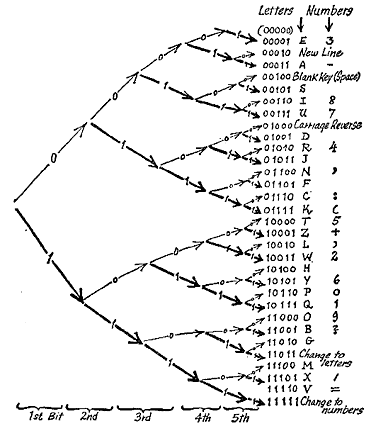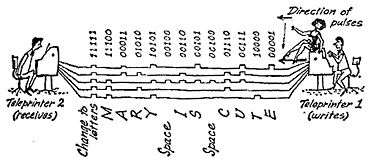The Concise language of the Computer
It is difficult enough for human beings to understand one another. Still, they try to do their best. Even tourists in Italy with no other language than their native English can make their intentions clear by exclaiming "Spaghetti!" or "Amore!" at the appropriate time.
But really serious difficulties arise when human beings wish to communicate with machines. Nothing is achieved at all with a smattering or even with a linguist's knowledge of a foreign language. The only thing that will help is an absolutely exact, precisely predetermined "mechanical language" that will be understood equally well by men and machines, a language that the machine will be able to cope with and that it will also know how to reproduce. Naturally, a mechanical language must consist of quite simple elements.
The first such language in the world was invented by the American portrait-painter, Samuel Finley Breese Morse, in 1837. His "Morse alphabet", in which all letters, numbers and punctuation marks are represented by dots and dashes, is such an ideal mechanical language that it can be transmitted by the simplest kind of apparatus without the slightest difficulty. Morse code can even be sent by a packet flashlight or a whistle.
Morse constructed his alphabet out of only two elements - dots and dashes - in other words in a purely binary form, although he may never have heard of the word "binary". Morse code signs can be translated into modern binary code symbols without further ado. The letter L, telegraphed as ". - . .", can be written equally well as "0100."' Seven in the Morse code, "- - . . .", can be represented by "11000". We need only substitute a "1" for every dash and an "0" for every dot.
A mechanical language made up only of dots and dashes, or, to talk in modern terms, of "0"s and "1"s, is particularly suitable für electronic computers. Both symbols can easily be electrically received, processed and transmitted. We need only say that "1" means "current" or "on" and that "0" means "no current" or "off". Electric switches can be set to "on" or "off" - and, according to the way they are set (either "1" or "0"), current will either flow or not flow through tubes, transistors and wires. Nothing could be more straight forward.
That is why most electronic computers in use today work binarily. We might suppose that the Morse code would be an ideal language für computers. In fact it has only one disadvantage: the groups of dots and dashes are of varying lengths. E is ".", M "- -", and S ". . .". Electronic computers must have their groups of signs all the same length, but that makes it easier to deal with them in all-automatic operation.
But we do not have to use the Morse code. So many different codes can be made out of the two elements "0" and "1" that there is not much risk of confusion between them. A very popular code in electronic circles, for example, is the sign-language used in teleprinters. It might have been designed especially für computers, though it was not. Automatic calculators which have been taught how to use the teleprinter code as a mechanical language can be linked up directly with the teleprinter network. In this way an engineer in London, for example, via the teleprinter in his office, can make calculations on an electronic computer in Edinburgh.

The teleprinter code is built up in just the same way as the "Tree of Knowledge", with its foliage of playing cards. But, while all the letters of the alphabet can easily be accommodated in the 32 combinations, numbers and punctuation marks cannot. So, it is necessary as in a typewriter - to change over from letters to numbers and symbols, etc.
In the teleprinter code, as in the playing cards, every symbol consists of five bits. We might speak of it as a "five-bit code". But the communication technicians bear in mind that these five bits will later on have to be forwarded electrically on five parallel wires, so they speak of it as a "five-channel code".
Let us write down a sentence in our five-channel code. What about "Mary is cute?" It would run like this:
11111 Change to letters
11100 Letter M
00011 Letter A
01010 Letter R
10101 Letter Y
00100 Space
00110 Letter I
00101 Letter S
00100 Space
01110 Letter C
00111 Letter U
10000 Letter T
00001 Letter E
Suppose we take another sentence: "Mary is 17." In teleprinter language it would look like this :
11111 Change to letters
11100 Letter M
00011 Letter A
01010 Letter R
10101 Letter Y
00100 Space
00110 Letter I
00101 Letter S
00100 Space
11011 Change to numbers
10111 Number 1
00111 Number 7
It seems a bit complicated. We can type such sentences in plain English more quickly than we can in the teleprinter code. But anyone who has ever seen an automatic teletypewriter rattling out its message will have to admit that it can deal with its code just as speedily as a typist can tap her keys.
But perhaps you have never seen such an apparatus?
From the outside, it looks rather like an overgrown typewriter. It has a typewriters keyboard, a typewriters type-bars (but without small letters) and a roller to hold the paper. If you tap away at the keys you can see just what is being typed on the paper. What you do not see is a bundle of electrical impulses which, for every letter typed, travels to another teleprinter installed somewhere else, perhaps hundreds of miles away, where it makes the second teleprinters type-levers move as they should.
Ratatatatat! - the teleprinter is at work. Trader Tompkinson of Birmingham types "referring to ..." to his friend and business colleague Higginson of Boston.
Ratatatat! - a fraction of a second later, "referring to ..." appears in Higginson's teleprinter.
The electrical pulses that race from one teleprinter to another obey the five-channel teleprinter code, and if Tompkinson wanted to write "Mary is cute" to Higginson, the result would look rather like the Illustration below (each "kink" or "bridge" in the wire is intended to represent an electrical impulse.)

©
by PhiloPhax & Lauftext
& Redaktion Lohberg
Kybernetik
- Was ist das?
First printed in Germany: 1963